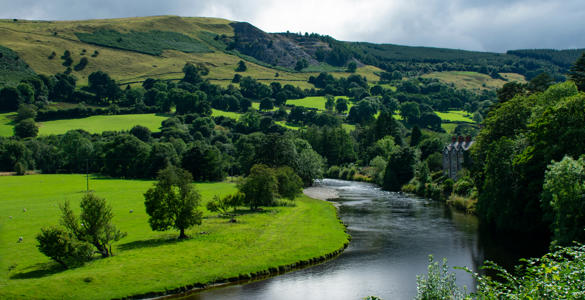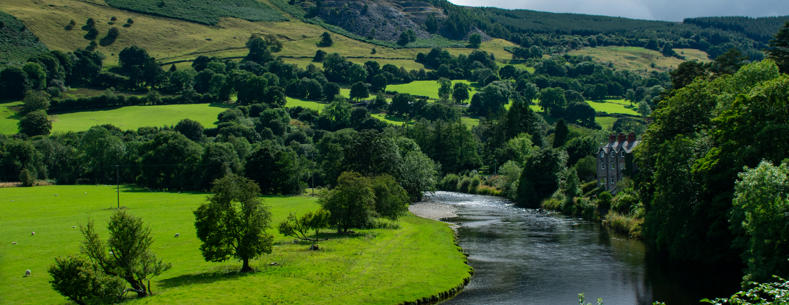Farmers have opposed the Welsh Government’s agricultural pollution regulations from the beginning, saying they’re “draconian” and “punitive”.
The Welsh Government insists the regulations are essential. Environmentalists argue they’re long overdue and will help stop “catastrophic” environmental damage.
While everyone agrees something must be done, the regulations continue to be contentious.
The Senedd debated annulling the regulations and NFU Cymru launched a legal challenge – both were ultimately unsuccessful.
The Senedd then agreed to review the regulations. This work fell to the Economy, Trade and Rural Affairs (ETRA) Committee.
The Welsh Government made a significant announcement on 5 October, ahead of the Senedd debate on the Committee’s findings on 12 October.
How polluting is agriculture?
There are many different sources of water pollution. Farming and the water industry are the two biggest causes of surface water pollution incidents reported to Natural Resources Wales (NRW). The dairy sector is responsible for most agricultural pollution incidents.
The Welsh Government says diffuse pollution from agriculture is one of the main reasons Welsh waterbodies fail to achieve ‘good status’ under the Water Framework Directive (WFD).
NRW data from 2021 identifies agriculture as the most frequent cause of WFD failures, being linked to 21% of all failures to reach good status. The water industry is linked to 15%.
Why has the Welsh Government taken this approach?
The regulations came into force in April 2021 and introduce an all-Wales ‘regulatory baseline’ to control agricultural pollution.
The Welsh Government says the regulations tackle the causes of agricultural pollution and help Wales meet international and domestic obligations.
They also aim to address risks associated with retrospective EU infraction proceedings, meet the level playing field requirements of the EU-UK Trade and Co-operation Agreement and demonstrate to global markets that Welsh food is produced to recognised standards.
Is this the same as the previous approach?
No. The regulations replace the previous approach under the Nitrates Directive. This designated 2.4% of Welsh land as ‘Nitrate Vulnerable Zones’ (NVZs) inside which farmers were subject to controls.
The Welsh Government emphasises the regulations aren’t NVZs extended across all of Wales. It says they replace NVZs entirely, and while the primary aim remains to reduce water pollution:
… the measures are designed to avoid pollution swapping and to prevent or minimise increased losses of nutrients to the environment. This includes nitrates, phosphorous, greenhouse gases and ammonia.
How’s the all-Wales approach been received?
Wales Environment Link (WEL) welcomes the cross-territory approach saying it makes Wales ready for farming intensification in new, more sensitive, areas, and places all farmers on a level playing field, avoiding a “competitive imbalance”.
WEL also says “if a farm does not produce slurry then the regulatory approach will have little impact on them”.
But the farming unions disagree. They would prefer measures targeted at areas where there are agricultural pollution issues. The Farmers Union of Wales (FUW) says the regulations:
… place a significantly greater regulatory burden on every farmer … including the majority, who have never suffered an agricultural pollution incident, and those in catchment areas where agricultural pollution incidents have not been recorded.
How much fertiliser can be applied?
The unions also oppose the limit placed on the amount of nitrogen that can be applied to land. The limit is set at 170kg per hectare per year.
Under the previous NVZ approach, farms with 80% grassland, and satisfying certain criteria, could apply up to 250kg/ha. NFU Cymru says the 170kg/ha limit is a:
… de facto stocking limit requiring destocking on many Welsh farms with impacts to farm viability, critical mass within the supply chain and employment.
The ETRA Committee recommended the Welsh Government should consider reintroducing a mechanism for qualifying grassland farms to increase their limit to 250kg/ha, because it was concerned Welsh farmers could be put at a competitive disadvantage.
WEL opposes reintroducing the higher limit saying alternative ways of managing animal waste should be found and if “evidence shows that a certain amount of destocking is necessary to protect our environment, then it should be considered”.
Under its Cooperation Agreement with Plaid Cymru, on 5 October the Welsh Government announced changes to how the limit would be introduced:
- The implementation date for the 170kg/ha limit would be extended from January 2023 to April 2023.
- The Welsh Government will consult on a licensing scheme this autumn under which farms can apply for a licence for a 250kg/ha limit. The scheme is proposed to run until 2025.
- The Welsh Government will undertake a Regulatory Impact Assessment on the economic and environmental impacts of the 170kg/ha limit.
What about alternative approaches?
The regulations allow alternative measures to be suggested within 18 months of the regulations coming into force –making 1 October 2022 the deadline for proposals.
The regulations control when, where and how fertilisers are applied, including preventing slurry spreading between October and January from 2024. This is known as the ‘closed period’.
FUW told the Committee that restrictions on slurry spreading during the closed period would put:
… pressure on cattle farmers to empty their stores before the closed period and spread as much as possible within the limits after the closed period … rather than spreading at the optimal time in regard to weather conditions and crop requirements.
The farming unions advocate exploring the use of technology to assist spreading at the optimal time rather than the ‘farming by calendar’ approach required by closed periods.
The Committee recommended the Welsh Government should prioritise alternative technology-based proposals in place of closed periods for spreading.
The Welsh Government responded saying any proposals would be considered equally and in line with the regulations, and prioritising proposals based on topic would be inappropriate.
Is NRW geared up to enforce the regulations?
We don’t know yet. NRW told the Committee this would be a “massive workload.” NRW estimated it needed 60 extra staff to deliver the “minimum viable product” but “well over 200” to deliver the “full role”.
Funding for this work has been considered through NRW’s budget baseline review exercise, which looked at NRW’s resource allocation against its statutory functions and Programme for Government commitments. The resulting service level agreements are due to be completed this month.
Has funding been made available to farmers?
Yes. The Minister told the Committee over £40 million has been made available to farmers to reduce pollution and support the necessary changes. But it wasn’t clear exactly which pots the funding came from and how much was new money, and how much redeployed from existing funding allocated to farming.
The Committee recommended the Welsh Government clarify exactly what support has been, and will be, available. The Welsh Government agreed but gave no timeframe.
In its 5 October announcement, the Welsh Government said it was making “up to” £20 million of “extra funding” available to support compliance with the regulations.
Robust debate has surrounded the regulations every step of the way. This will no doubt continue on 12 October when the Senedd discusses the ETRA Committee’s report.
You can follow the debate live on Senedd TV.
Article by Elfyn Henderson, Senedd Research, Welsh Parliament






